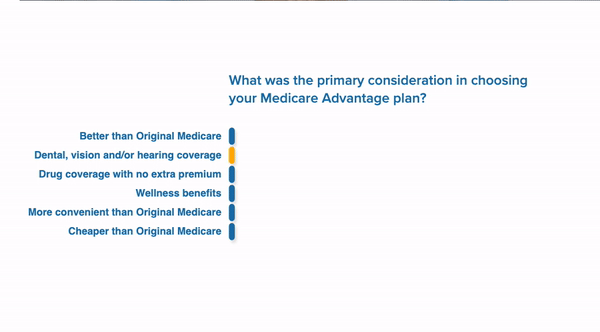Medicare Part C, also known as Medicare Advantage, is available to any eligible Medicare beneficiary enrolled in Part A and Part B. Private insurance companies, such as BlueCross BlueShield, Humana, and UnitedHealthcare,1 contract with Medicare to supply health services to plan members. And they also provide additional benefits and financial protection. Almost all Part C plans require you to use the plan’s network of physicians and hospitals to have costs fully covered.
What Does Medicare Advantage Cover?
Medicare Advantage plans must cover everything that Original Medicare covers, including inpatient hospital and skilled nursing facility care, emergency and urgent care, doctor visits, surgery, preventive care, certain vaccines and medical equipment such as wheelchairs and walkers. 2
Medicare Advantage plans may also cover additional services not included in Part A and Part B.
What Are the Part C Network Types?
Medicare Advantage plans are required to include in their networks physicians from each of the 26 medical specialties, chiropractic care, and hospitals in your area.4 There are several types of plans.
HMO (Health Maintenance Organization)
Over 55% of all Medicare Advantage enrollees are in HMOs.5 HMOs generally cover only services performed by in-network providers except for medically necessary emergency care. Premiums and cost-sharing (deductibles, copays, coinsurance) can be lower for HMOs.
PPO (Preferred Provider Organization)
Almost a third (36%) of Medicare Advantage enrollment in 2021 was in PPOs.6 PPOs offer greater choice of physicians and hospitals but can be a more expensive option. They cover care by in- and out-of-network providers but at a higher cost to the plan member.
Other Kinds of Plans
A small number of beneficiaries have the option of Private Fee-for-Service (PFFS) plans and Medicare Medical Savings Accounts (MSA) plans.
Special Needs Plans (SNPs) for those eligible for both Medicare and Medicaid).
Group plans sponsored by some employers or unions are available to some Medicare beneficiaries.7
Who Is Eligible for Medicare Advantage?
Anyone over 65 years of age who is enrolled in Medicare Part A and Part B may opt for a Medicare Advantage plan that serves their geographic area. If you are receiving Social Security Disability (SSDI) benefits, you will be enrolled automatically in Medicare when you become eligible, usually after you have been receiving SSDI benefits for two years.
An exception used to be people with end-stage renal disease (ESRD), which requires regular dialysis or a kidney transplant. Starting in 2021, Medicare Advantage plans now offer coverage for ESRD.
Prior to 2021, you could only keep your Medicare Advantage plan if you were enrolled and developed ESRD. Another way was if you enrolled in a Special Needs Plan.
What Does Medicare Advantage Cost?
Medicare Advantage plans vary significantly in cost and quality. Here are some of the factors to consider when comparing policies.
Premiums
Medicare Advantage plans usually have little or no monthly premium. The average monthly premium is around $18.50 in 2024 Premiums vary across the country. Enrollees still have to pay their Medicare Part B premium.
Deductible
Before your coverage kicks in, you may have to meet a deductible. While some Medicare Advantage plans have separate deductibles for medical care and prescription drugs, others do not.
Copayments
Copayments of $10 or $20 may be required every time you see a doctor or visit a lab. Also, you will face daily copayments if you spend time in a hospital. Consider your medical usage to estimate how much of these costs you’re likely to have to pay.
Coinsurance
With Original Medicare, you are responsible for 20% of approved costs. In many Medicare Advantage plans, you will pay coinsurance for high-priced medical services, such as diagnostic imaging, chemotherapy, radiation, and dialysis, or in some PPO plans, a percentage of the cost for out-of-network services.
Out-of-Pocket Maximum
Medicare Advantage plans are required to limit your out-of-pocket spending. In-network costs are capped at a maximum of $8,850 a year. In Original Medicare, there is no limit to what your 20% share of medical expenses can mount up to in a bad health year.
When Can You Enroll in Medicare Advantage?
The first step is to sign up for Medicare Part A and Part B. You can do that by contacting Social Security directly. After that, there are several enrollment periods to know.
Initial Enrollment Period
You can enroll in a Part C plan during the seven-month period that starts three months before you turn 65 and ends three months after.
Medicare Open Enrollment Period
From October 15 – December 7, you can enroll in Medicare Advantage plans for the following year. The plans and your needs may change so it’s worth reviewing your options during open enrollment each year and changing to a different Medicare Advantage plan that better meets your needs.
Medicare Advantage Open Enrollment Period
From January 1 to March 31 each year, you can switch from one Medicare Advantage plan to another or return to Original Medicare and enroll in Part D prescription drug coverage.
Special Enrollment Period
In particular situations, such as if you move or lose health coverage, you may be eligible for a special enrollment period. 11
What Are the Pros and Cons of Medicare Advantage
Pros
Lower upfront costs. Some plans do not charge a monthly premium. \
One-stop shopping. Plus, Medicare Advantage saves the costs of a Medicare Supplement plan, which most Original Medicare enrollees buy to help pay the 20% of costs that are their responsibility.
Those costs also include other deductibles and cost sharing, like the Part A hospitalization deductible. For a 65-year-old woman, these policies range from $118 to $464 per month, although a less-expensive high-deductible plan is also available.12
Cap on out-of-pocket costs. Medicare Advantage has a cap on your out-of-pocket spending.
Cons
Limited choice of providers and hospitals. HMOs generally require you use only providers in their network. In PPOs, you will usually pay more of the bill when you use out-of-network providers. Original Medicare allows you to use any provider or hospital that accepts Medicare, and the vast majority do.
Geographical limits. Care may not be covered if it’s outside of the plan’s geographic area. Original Medicare allows care anywhere in the country. Geographical limits may be problematic for people who travel frequently or have residences in two areas.
Pre-authorizations and referrals may be needed. Medicare Advantage plans may require referrals to see specialists and require prior authorization of procedures. Problems with denial of care and payment are “widespread” in Advantage plans, according to a recent government report.13
Try to choose a plan that’s highly rated by members. You can find ratings for plans in your state at NCQA.14
Next Steps
Once you’ve completed enrollment in Medicare Part A and Part B, consult a trusted advisor for your Medicare Advantage options. After answering a few questions, you will get a complete list of the plans available in your zip code. Information on premiums, deductibles, copays, and out-of-pocket limits are available for each plan.
Working with a licensed Medicare agent allows you to compare plans and learn about your coverage and drug options. You can also ask about star ratings, which rate quality and performance based on surveys of plans, health care providers and member satisfaction. A plan can get a rating from 1 to 5 stars, with 5 being considered excellent.
Narrowing your list to plans that combine the benefits you need most, a cost you can afford and a good star rating, will help you choose the right plan for your needs.


